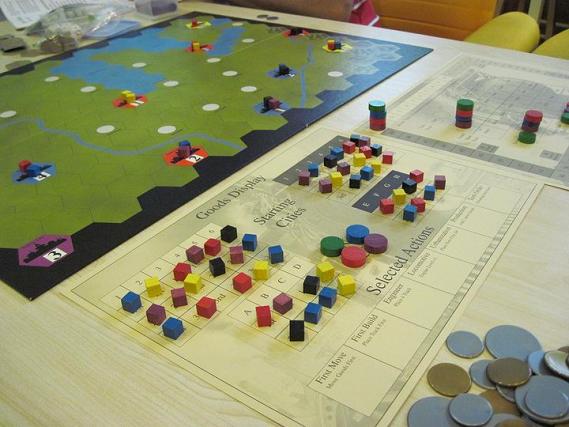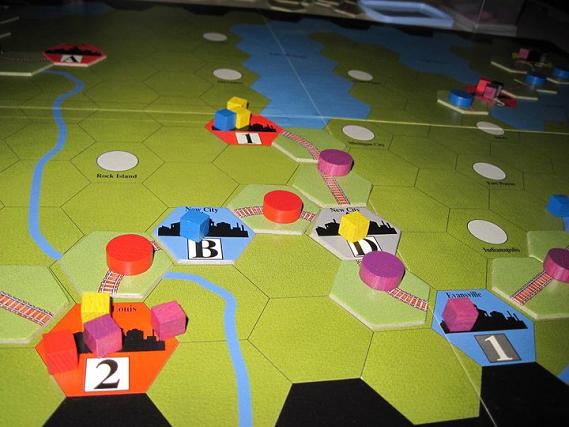
Just some quick thoughts on this as I feel that I really need to play it some more to decide what to think about it. I’d have waited for later but Sean seems quite insistent, plus it’d probably be a while before I get to play it again.
- The low quality of the components are a real turn-off. I thought I’d be able to deal with this better but this game reminded me that a significant portion of the enjoyment of playing boardgames stems from the tactile pleasure of handling quality components. I did buy animeeples from Sean for Agricola after all.
- More than anything else, the gameplay reminds me of Power Grid. I found it to be very dry, consisting mainly of straightforward, brute force calculations. As in Power Grid, the costs of whatever it is you want to do is mostly fixed with the only source of variation being the auction at the beginning of the turn. In Power Grid, you’re auctioning for power plants whereas in Age of Steam, the auction is for turn order and consequently the choice of special advantages for the turn. But the effect feels much the same to me. Age of Steam even punishes you if you get your maths wrong and issue more shares than you need funding for in a turn.
- Much like Power Grid as well, there’s an element of area control in this game. I failed to appreciate the significance of the patch of water on the map and how it constricted the space available for rail networks to traverse the horizontal length of the map. Knowing how to build a network such that goods are able to be shipped the longest possible distance is important too. I tend not to be good at games with this element as I’m slow at processing all that visual information.
- For all these reasons, I’d say that this game is extremely vulnerable to analysis paralysis. Trying to make sense of the map once it has multiple rail networks crisscrossing it is a daunting challenge indeed. As I sat on one edge of the map, I tended only to pay attention to my side of the map. Woe betide you if you actually want to put effort into anticipating where new goods might pop up and adjust your rail network accordingly.
- Overall, I have to say that it does strike me as a very good game for people who like this sort of thing. It rewards very detailed planning and meticulous calculation. I think I prefer games in which you have to go more by gut because it’s harder to break down your decisions into such nakedly straightforward terms, such as Agricola and Le Havre. The extended calculations needed for games like Age of Steam tend to wear me out so I barely even try to win. Surprisingly my wife, despite being not much of a gamer, is better than me at Power Grid and Age of Steam, as the cost and benefits of various decisions are easier to grasp for her.

EDIT: I forgot to mention one last thing. During our game, Sean talked about how the creator of the game lost control over it due to a lawsuit. I briefly went to read up on it and it seems that the amount of money in dispute comes to only about USD$10,000. That’s really not a very significant sum at all and it rams home for me how small the boardgames industry is. For example, the creator of one recent Flash game, Steambirds (which reminds me a lot of the Wings of War boardgame, but with special powers), just revealed some details about his finances and said that he received USD$25,000 just from one website for the first right to use his game on it. While I have no doubt that really monster-sized hits like Magic: The Gathering rake in cash by the truckload, I have to conclude that most games don’t really make much money at all.
6 Responses to “Age of Steam”
Age of Steam is all about the planning. The cubes distribution at the start of the game, the cubes to be distributed to the middle of the game and the end game. The most valuable resource in this game is actually the actions. Money is only the grease that determines how much you get to bid for the actions. Selecting actions like locomotive will save you an upgrade train move. Investing your actions early to upgrade trains also will save your moves by delivering further per action.
Yes, this may sound dry and boring but this is the ‘zen’ state you should reach once the game clicks for you. At that stage, you’re not worrying about the nitty gritty details as much but more about the overall plan. Sometimes I just tell new players, stop optimising, issue more shares to cover your ass, the game isn’t won by those who can save their money (but their actions).
But even trying to anticipate where new goods will appear and consequently the possible new paths that are available to ship them along is a huge chore. It’s something that needs to be meticulously fussed over, not something that can be intuitively grasped.
It seems to me that the planning in this game does depend on all these tiny details. Maybe I just need to play to see it differently, but so far it seems to me that this game is won by whoever can micromanage the most minutely.
well, try to focus on the overall picture, expand your options and not obsessively micromanage until every last detail, because the opponents can and will screw you up. Your strategy should be to find uncontested areas and to control those links. A typical strategy can be to link the board from end to end, especially in the base map as the yellow and purple cities are placed on both ends. Another strategy is to make circular routes so that deliveries that are one city away can go on a merry go round and end up going through 5 or 6 links.
If the above idea clicks for you, you don’t have to micromanage much. That being said, the obsessive micromanagement does comes in IF the players are evenly matched. Then again, I’ve seen an obsessively micromanaged game of Samurai between 4 evenly matched players went to two and a half hours!
Trackbacks
Leave a Reply